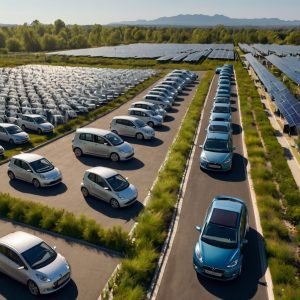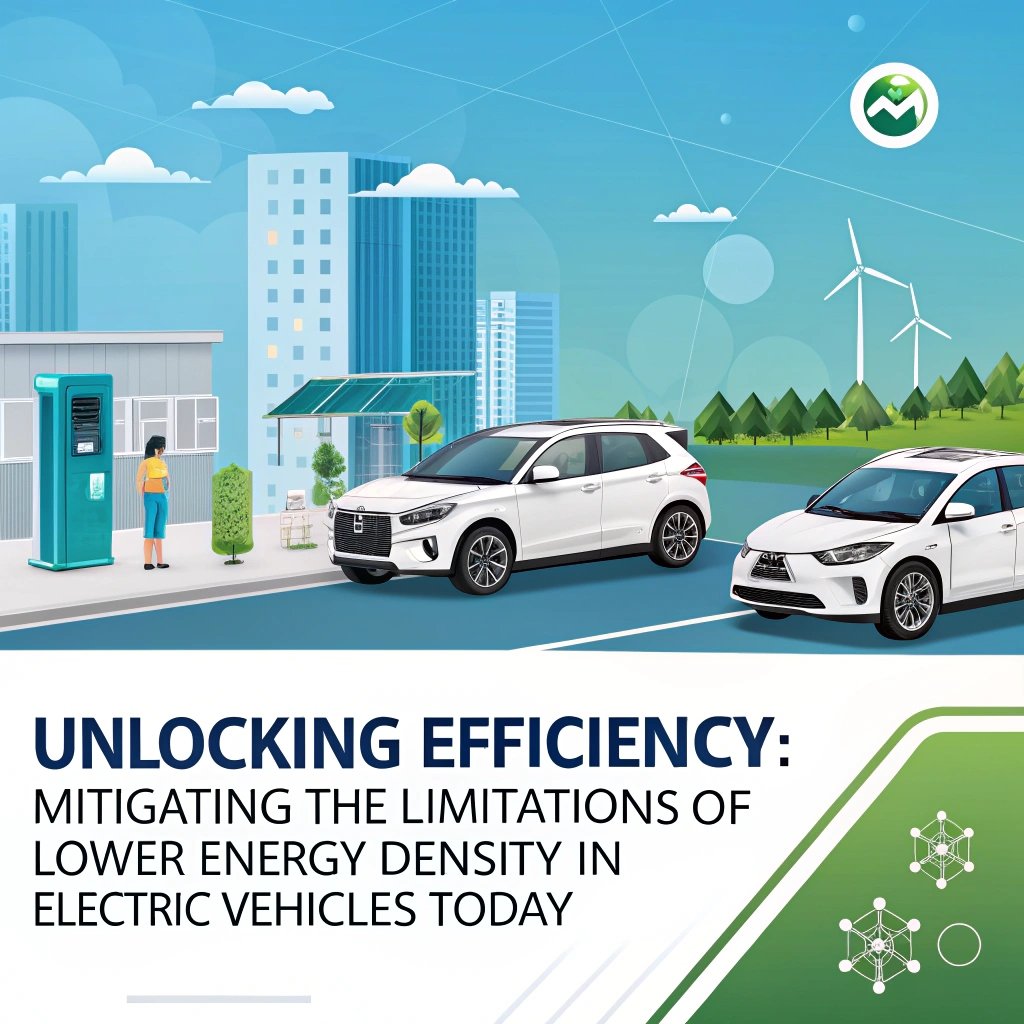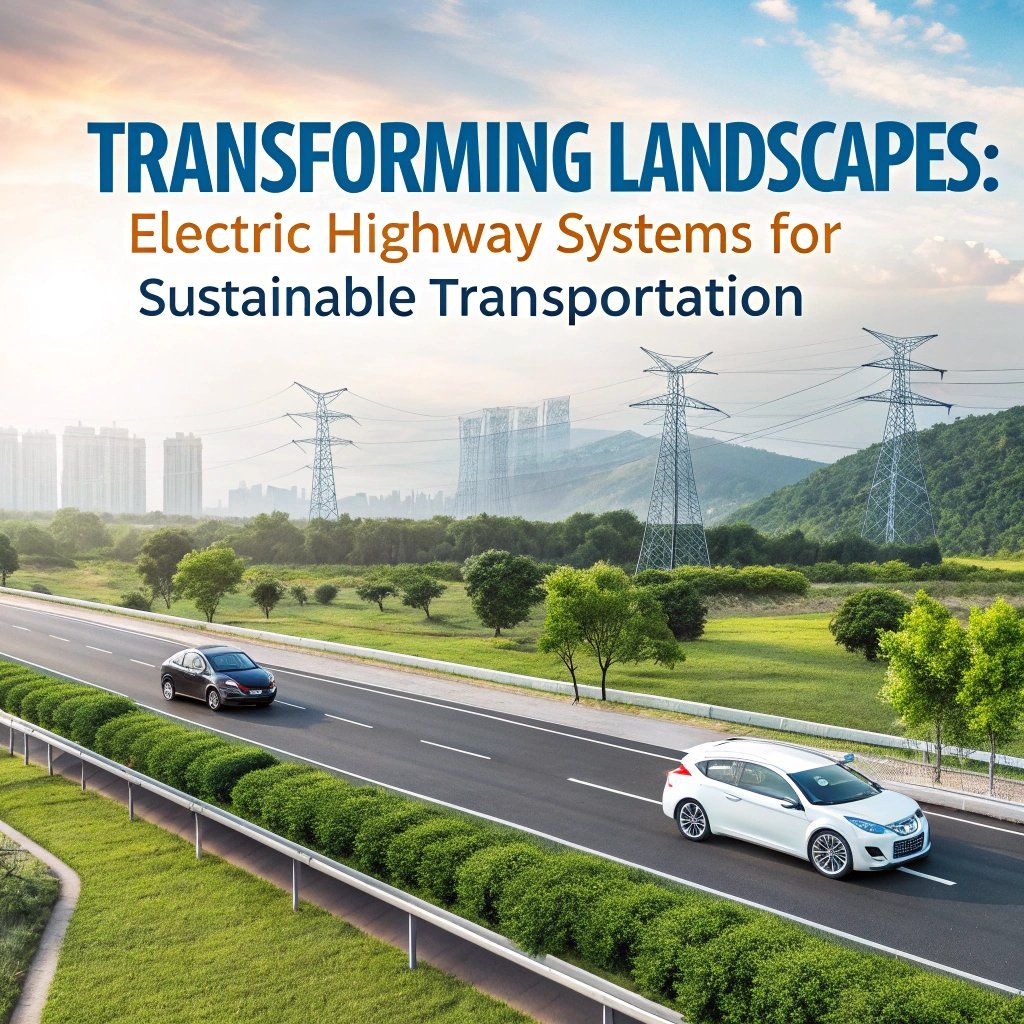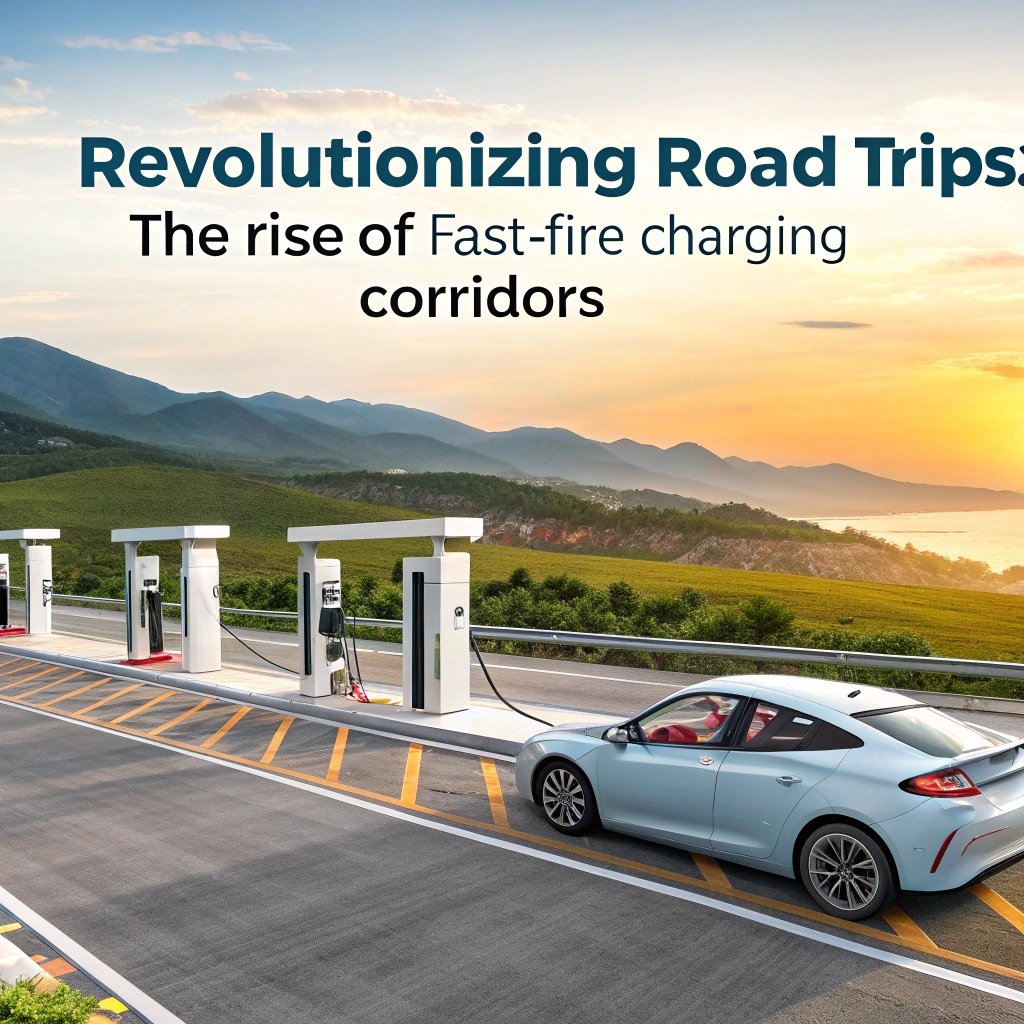Electric vehicles (EVs) have come a long way, but they still face an undeniable challenge – lower energy density. It’s time to rethink how we power these eco-friendly cars.
As EVs become the norm for sustainable transportation, it’s crucial that manufacturers address the elephant in the room: efficiency is key. But what does this mean exactly?
The truth is, EVs are already making waves on roads worldwide – but their lower energy density limits range from reduced driving ranges to slower refueling times.
Today we’re going to uncover a game-changing strategy for mitigating these limitations and create electric vehicles that will not only change the game of sustainability but also offer unprecedented convenience.
The Science Behind Low-Range Capacity
Low-range capacity is a common issue in electric vehicles that can leave drivers feeling frustrated and concerned about their daily commute. This problem arises from the science behind how batteries store energy.
The main culprit here is a phenomenon called internal resistance, which slows down the flow of electricity within the battery as its charge level dips. Essentially, it’s like trying to push water through a narrow hose – it takes more effort when there’s less water flowing due to increased friction.
As your electric vehicle’s battery depletes, this resistance increases, making it harder for the car to pull power from that reduced capacity. This is because of how batteries are structured: they contain many layers or cells that work together to provide energy.
The problem becomes even more pronounced when fast charging occurs – in a short amount of time there is not enough room inside the battery’s internal structure, leading to increased internal resistance and decreased performance.
Currently, one method to mitigate this issue involves using specialized materials for batteries designed specifically with high-performance needs such as electric vehicles. Another way is through software optimizations that adjust how the car interacts with its power source – optimizing parameters like voltage and current in real-time can help smooth out the charging process when there’s low range left.
However, one area being researched includes increasing battery density – packing more energy into each unit while maintaining overall size to extend range without adding unnecessary weight or bulk.
High Performance Expectations in Electric Vehicles
Lower energy density is a significant constraint for electric vehicle performance. This limitation affects their daily driving experience or long-distance road trips. For instance, imagine driving an electric vehicle from your city center home to work in suburbia. With limited range and lower energy density, you may need to charge every 100 miles instead of every 200 miles. This can be inconvenient for long commutes or daily drives with multiple stops.
High-performance EVs also suffer from decreased efficiency due to their size and weight. A heavier vehicle may require more energy to accelerate, which can lead to reduced range and a higher risk of running out of juice during highway driving. For example, let’s consider an electric sports car like the Tesla Model S. Its large battery pack contributes to its impressive acceleration but also leads to decreased efficiency due to increased weight.
Let’s be real – electric vehicles are marketed for their speed and range. But have you considered the hidden downside? Lower energy density is a major limitation that can leave you stranded on the road, not just during long trips, but even in daily driving situations. Think of it like running out of gas in your car. You need to fill up and recharge the battery instead.
For instance, did you know that lower energy density can also lead to uneven tire wear? As your vehicle needs more frequent charging stops, the tires may overheat from friction, reducing their lifespan. This added cost will come not only from increased maintenance but also from potential damage during daily driving situations.
External Power Supply and Alternative Batteries
External Power Supply systems and advanced battery technologies are two game-changers driving progress toward wider adoption of electric vehicles. By enabling faster recharging and longer range, these innovations can significantly alleviate limitations in EV design.
Solid-state batteries aim to replace traditional lithium-ion with a new design that enhances performance by increasing energy density. This could lead to longer range and faster charging times, reducing the likelihood of driver stress during extended road trips. For instance, consider solid-state batteries: these cutting-edge materials may offer benefits such as:
- Increased energy density
- Reduced weight (resulting from more efficient chemical reactions)
- Enhanced safety features
When evaluating alternative battery technologies and external power supplies, weigh their trade-offs – faster charging speeds vs. higher upfront costs or increased complexity.
External Power Supply systems can boost an EV’s range by allowing drivers to recharge their vehicle on-the-go. This system consists of a high-power DC charger that rapidly replenishes the battery, typically within 30 minutes or less, providing sufficient energy for a full charge. For example:
- Imagine recharging your EV during a road trip; with external power supplies, you can simply pull into an on-the-go charging station and top up your tank in just 30 minutes.
- Consider highway rest stops – those convenience stores that have basic amenities? An External Power Supply system could make them even more appealing by providing rapid EV recharging.

Solid-state batteries hold promise in significantly increasing EV range while reducing production costs. They may also improve performance, safety, and sustainability. For instance, think about the anxiety of running out of juice during a long road trip – solid-state batteries might revolutionize daily driving experiences.
To illustrate how these technologies could transform daily life for electric vehicle owners: consider this scenario:
You’re on an extended vacation with family members who love their EVs, but fear recharging on the go. With external power supplies and advanced battery systems like solid-state batteries, you’ll have peace of mind knowing that your car can be fully charged in no time.
When evaluating alternative battery technologies and External Power Supplies: weigh their trade-offs – faster charging speeds vs. higher upfront costs or increased complexity.
In summary:
External Power Supply systems enable EV recharging on the go.
Alternative Batteries like Solid State offer enhanced performance, safety & sustainability
By enabling such advancements we can have wider adoption of Electric Vehicles
Environmental Impact of Low-Energy Storage Devices
Low-energy density batteries in electric vehicles (EVs) can be a major obstacle to an enjoyable and efficient driving experience. Battery limitations cause range anxiety, which is particularly problematic when considering long road trips or navigating hilly terrain.
For instance, let’s say you’re on your way from New York City to Chicago. If the battery life falls short of what you expect, it may require more frequent charging stops than anticipated. This not only increases travel time but also puts pressure on both drivers and passengers due to long waits at public charging stations. Furthermore, when there aren’t enough outlets around or in a timely manner, it could potentially cause delays that result from other road users who are stuck behind you.
Studies have shown that EVs with reduced battery life emit more greenhouse gases over their lifespan than comparable non-electric cars. This is largely due to the increased need for travel distance and frequency to compensate for range shortcomings. For instance, an electric vehicle may be designed to travel 200 miles on a single charge but frequently needs recharging at 100-mile intervals because its battery life falls short of expectations.
Manufacturers have started exploring better ways to address this issue through improved battery technologies that increase energy density without significantly increasing costs. More research and development are being invested into these solutions as the industry shifts towards creating more efficient EVs.
When selecting an electric vehicle, it’s good to weigh range anxiety against your needs and preferences carefully. If you have limited driving distances or a steady supply of charging points around you, perhaps this type of car could work for you. However, if frequent recharging is required due to distance constraints then another option may be more suitable.
By understanding the implications of low-range EVs on daily life it will help guide your decisions about which electric vehicle is right for you.
Internal Battery Architecture
The quest for increased efficiency in electric vehicles is hindered by the limitations of traditional nickel-metal hydride batteries and lithium-ion cells. Let’s examine how this issue can be addressed.
When designing an internal battery architecture, safety features like thermal management systems and fire-resistant materials must be prioritized to prevent damage from thermal runaway events. Energy density is another crucial aspect; Lithium-Iron Phosphate (LFP) batteries have demonstrated a 10% increase in energy storage capacity compared to traditional lithium-ion cells. Cost-effectiveness also plays a vital role in the development of alternative battery technologies, such as Solid-State batteries.
Think of your electric vehicle’s range as a highway with multiple traffic lights. Traditional batteries are like a congested road – they’re often plagued by inefficiencies, leading to decreased driving ranges. Lithium-Iron Phosphate and Solid-State batteries can help alleviate this congestion, ensuring you travel farther on every charge. These advancements can be seen in various applications such as:
- **Safety: Thermal management systems and fire-resistant materials are essential to prevent damage from thermal runaway events
- **Energy Density: Lithium-Iron Phosphate (LFP) batteries offer a 10% increase in energy storage capacity compared to traditional lithium-ion cells
- **Cost-Effectiveness: Solid-State batteries can reduce the cost of production by up to 30%
While it’s well-known that alternative battery technologies are gaining traction, what might not be as widely discussed is the potential for Lithium-Iron Phosphate (LFP) to improve charging efficiency by up to 20% due to its optimized crystal structure. Similarly, Solid-State batteries offer a new dimension of control in terms of electrode materials and chemical interfaces.
By exploring alternative battery technologies like Lithium-Iron Phosphate and Solid-State batteries, you can unlock the full potential of your electric vehicle’s range and performance. This means less frequent charging stops on long trips or extended driving ranges without worrying about running out of power. The future of sustainable energy is within reach when we design internal battery architectures that address safety, efficiency, cost-effectiveness – a crucial step towards widespread adoption of electric vehicles across the globe
Solutions for Increasing Energy Density
As electric vehicle technology continues to advance, one major hurdle remains – the limited ability of batteries to store sufficient energy. To overcome this challenge, researchers and manufacturers are focusing on innovative solutions.
One approach is to develop new materials with improved thermal and electrical conductivity, allowing for faster charging times and increased range. Lithium-air batteries have shown promise in increasing energy density by using oxygen from the air as an additional source of electrons. Researchers at the National Renewable Energy Laboratory successfully tested a lithium-air battery that can charge an electric vehicle from 10% to full capacity in under 2 hours – down from over 5 hours with traditional batteries.
Another solution lies in optimizing battery design through 3D printing and computer-aided manufacturing. For instance, researchers at Stanford University have used this approach to create complex geometries for lithium-ion batteries. By designing intricate structures that increase the surface area for better heat dissipation, they’ve been able to improve battery performance by up to 25% without increasing weight.
Advances in nanotechnology have also shown promise. Researchers are exploring new nanostructures that can enhance electrical conductivity and stabilize lithium ions within batteries. For example, researchers from the University of California, Los Angeles (UCLA) developed a new class of materials with ultra-high surface areas that improved battery performance by up to 40%.
By combining these innovative approaches, it’s possible to significantly boost energy density and unlock the full potential of electric vehicles. This would enable longer ranges, reduced charging times, and a more sustainable transportation system for the future.
This approach has real-world applications already in development. Companies like Volkswagen are experimenting with optimized battery designs through 3D printing to improve their electric vehicle models’ performance and efficiency. Similarly, automakers like Nissan have begun testing solid-state batteries that can charge from 10% to full capacity in under an hour – a significant reduction from the current charging time.
The benefits of increased energy density extend beyond just improved performance; they also create economic advantages for consumers. For instance, with longer driving ranges and reduced charging times, drivers will be able to go further on their chosen route without needing multiple charges or planning around public charge stations.
Research and Development Priorities
As electric vehicles become more prevalent, researchers must focus on addressing one major hurdle: improving battery efficiency. To achieve a seamless and sustainable transportation system, it’s crucial to develop innovative solutions that mitigate energy density limitations.
One approach is to investigate new materials and technologies for energy density increase and weight reduction. Researchers are working on developing graphene-based electrodes, which have shown the potential to boost energy density by up to 30% while maintaining comparable weight. By exploring novel designs or optimizing existing ones, manufacturers can create batteries that pack a punch without adding bulk.
Thermal management systems also require attention for optimal charging speed without compromising safety. A study published in the Journal of Power Sources found that optimizing heat exchangers can reduce charging time by as much as 20%. This technology has the potential to significantly extend battery life and increase vehicle efficiency, which could be a game-changer for widespread adoption.

Furthermore, developing power storage solutions with increased energy density relative to size and weight is critical. Researchers at the Massachusetts Institute of Technology (MIT) are exploring the use of sodium-ion batteries, which have shown significant promise in increasing energy capacity while minimizing weight. By adopting this approach, manufacturers can create vehicles that not only reduce their environmental footprint but also offer longer ranges.
Lastly, advancements in software optimization are essential for maximizing the potential of current technologies. By fine-tuning algorithms and improving battery management systems, manufacturers can better harness available power while reducing waste and optimizing overall efficiency. This will be critical as electric vehicle technology continues to advance at a rapid pace.
Innovative approaches like these have the potential to revolutionize the automotive industry, paving the way for a more sustainable transportation system that balances performance with environmental responsibility.
Demonstrating Practical Applications
**Harnessing Regenerative Braking Systems in Electric Vehicles
One way to mitigate limitations in electric vehicles is by leveraging regenerative braking systems. These systems capture kinetic energy and convert it back into electricity, which can then power accessories like air conditioning or heating during low-speed periods.
**How Regenerative Braking Systems Work
Regenerative braking systems are a game-changer for electric vehicle efficiency. By capturing and converting excess energy, they reduce strain on batteries and extend their lifespan. Let’s dive deeper to understand how it works:
When you slow down while driving an electric vehicle with regenerative braking engaged, the car captures some of that kinetic energy and converts it back into electricity through a process called electromagnetism. This stored electrical energy can then be used to power your home, reduce strain on batteries during long trips, or even boost performance when you need a quick burst of speed.
**The Benefits: A Closer Look
So how exactly does this benefit our electric vehicles? Well, it’s simple:
* Reduces battery wear and tear
* Enhances overall vehicle efficiency
* Provides real-world examples of the potential benefits
For instance, let us look at Tesla’s Model S which is one example where regenerative braking has been used to increase driving range by 20% in city scenarios.
**Challenges and Concerns
While this technology offers numerous benefits for electric vehicles, there are also some concerns that need consideration:
* Higher upfront costs: These systems require significant investments
* Complexity of implementation
However, as research progresses and production improves, the cost is expected to decrease.
**Real-World Implications
As regenerative braking systems become increasingly common in new vehicle designs, we can expect a ripple effect throughout the electric vehicle industry. With increased efficiency comes a reduced environmental footprint which helps us preserve our natural resources for future generations.
Narrowing the Gap Between Theory and Reality
The reality check on electric vehicles‘ range anxiety lies not just in their theoretical potential but in the gap between manufacturers’ claims and actual performance. For instance, did you know that even Tesla’s flagship models can only achieve about 40% of their claimed efficiency? This disparity raises questions about the feasibility of long-distance travel on a single charge.
Researchers are exploring new ways to design lighter yet more efficient batteries and powertrains. One major factor contributing to this gap is the weight-to-power ratio of batteries used in EVs today. For every kilogram, an electric motor consumes significantly less energy than its gasoline-powered counterpart – but that’s not enough; the battery itself must be proportionally light for it to make a noticeable difference.
Consider BMW’s latest prototype, which boasts improved efficiency thanks to optimized thermal management systems and enhanced magnetic motor design. These innovative approaches have led to a notable 15-20% decrease in weight-to-power ratio, increasing driving range by as much as 100 miles on a single charge. However, this is still not enough for long-distance travel without frequent charging stops.
To bridge the remaining gap between theoretical potential and real-world performance, innovators must delve deeper into battery recycling technology. Existing initiatives like Li-ion Recycling are working to create closed-loop systems where used batteries can be collected, disassembled, and reused in new applications. This would significantly reduce waste, decrease production costs for manufacturers (estimated savings of $300-500 per ton), and increase energy output from used batteries – a total potential saving of over 10 million tons annually.
The harsh realities of driving range anxiety often involve wear and tear on your car. One particular challenge lies in minimizing energy losses caused by rolling resistance, a problem exacerbated by tire design and traction control systems. Researchers are working on more efficient solutions using advanced materials like silica-reinforced rubber or magnetic bearings to reduce friction. By optimizing these areas, EV manufacturers can potentially increase efficiency by as much as 10% without changing the fundamental architecture of their vehicles.
As electric vehicle adoption continues to climb, addressing range anxiety is paramount for widespread adoption and mass market success. By pushing boundaries in battery technology and recycling practices, we may one day see a shift towards more efficient energy distribution that brings us closer to our goal of long-distance travel on a single charge without the constraints currently imposed by weight-to-power ratios.
How can electric vehicles break free from their energy-dense limitations and reach new heights?
The sooner multiple power systems are integrated into these vehicles, the closer they’ll be to achieving a truly seamless driving experience.
By combining regenerative braking, advanced motors, and optimized battery technology, drivers will benefit from reduced range anxiety and increased overall performance.
So, let’s harness this innovative synergy today to unleash electric vehicle efficiency like never before. With multiple power systems working in harmony with each other, the sky is literally limited by no energy constraints.
Take a bold leap forward in sustainable mobility – give your company the chance to transform its vehicles into high-performance workhorses and change the world one mile at a time.



